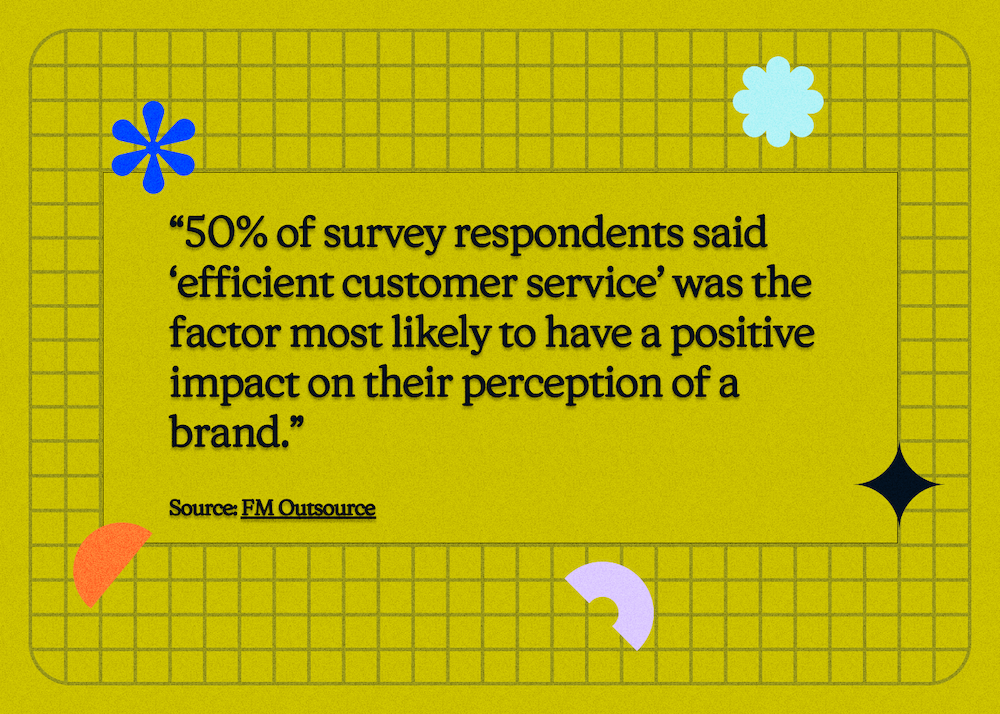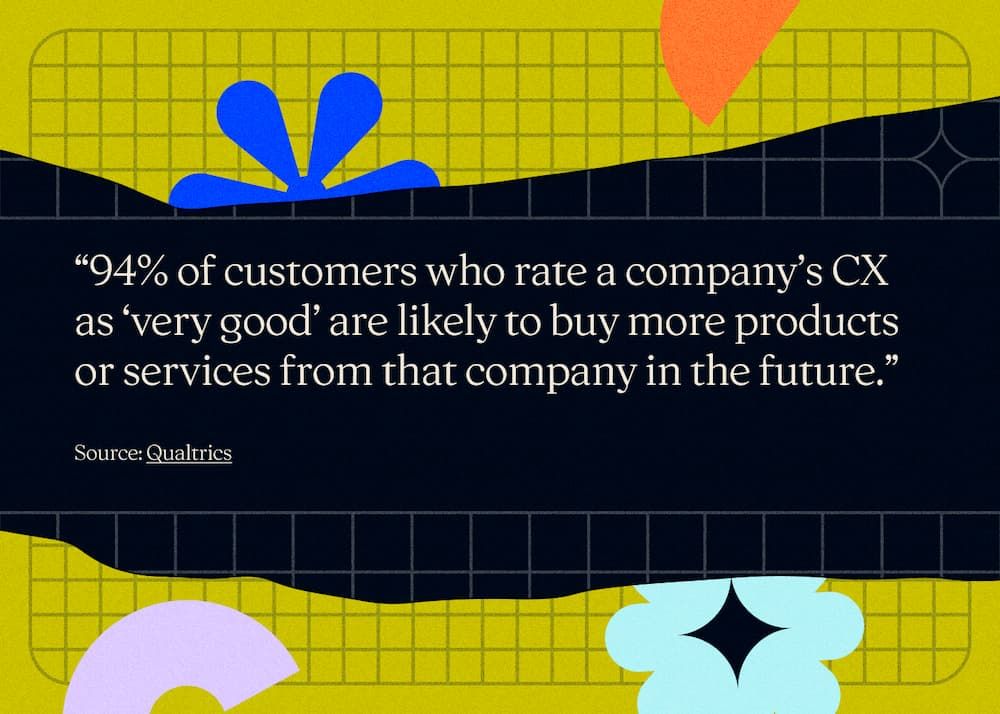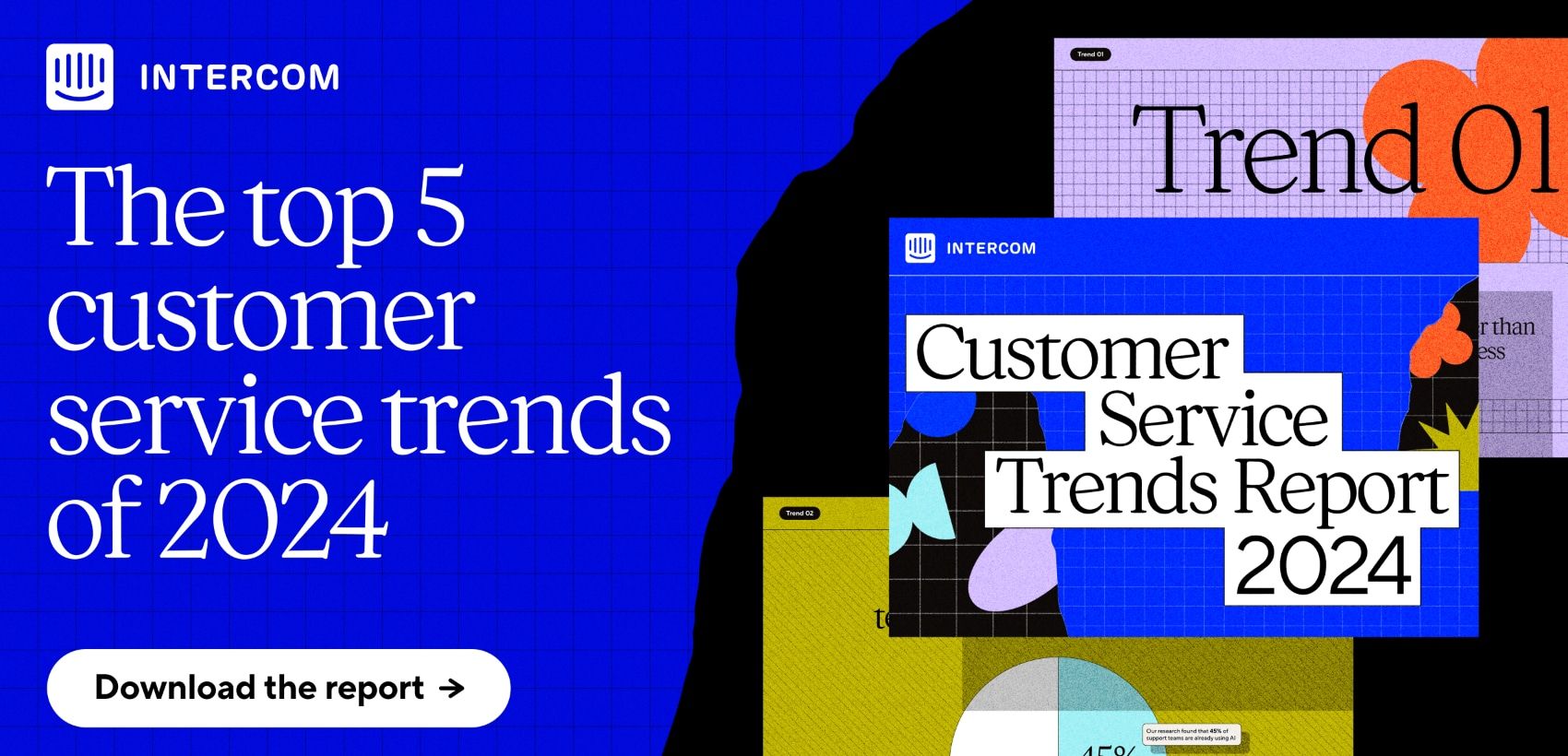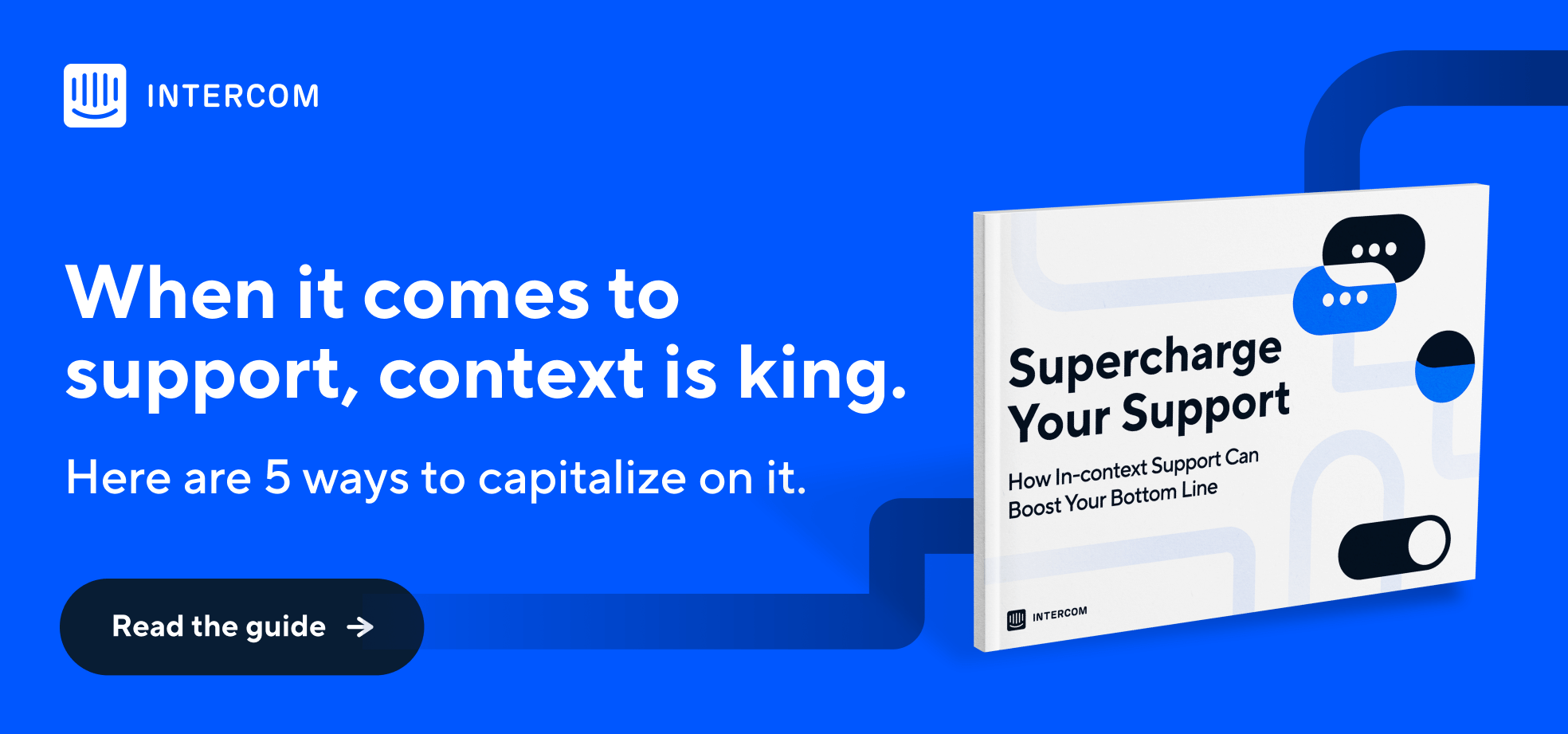
What is customer service and why is it important?
Related Content:
- Intercom's customer data platform
- Intercom customer support software
- Intercom product demos
- Support your customers more efficiently with automated customer service
- Human support
- Defining customer support in 2023
- Supporting customers in context
- 2022 Customer Service Quality Benchmark Report
- What is customer self-service?
In today’s competitive business landscape, customer service has become a crucial differentiator.
Modern customers are looking for exceptional experiences – and this includes the customer service they receive.
Nowadays, the quality of your customer service can make or break your business’s growth. According to Gartner, 89% of companies now expect to compete mostly on the basis of customer experience (CX). Another study found that 93% of customers were likely to return and make repeat purchases at companies with excellent service, while 80% said they had stopped doing business with a company because of a poor customer experience.
With retention top of mind for many forward-thinking businesses, it’s never been more important to provide world-class customer support. But what exactly is customer service, and how do you deliver fast, helpful experiences that make customers happy? Read on to learn more.
What does customer service mean?
Customer service is the support you provide to your customers (and potential customers) throughout the customer journey. Its goal is to address customer needs by resolving issues, troubleshooting problems, and helping them to get the most from your product or service.
“Everyone who interacts with customers has a role to play in providing excellent customer service”
While often considered to be the sole responsibility of your customer support team, everyone who interacts with customers – from sales to customer success – has a role to play in providing excellent service.
The importance of customer service
Customer service is a hugely important factor in keeping customers happy and engaged with your business. And happy and engaged customers buy more, come back again and again, and make recommendations to their friends and family.
We’ve already seen that great service can improve retention, while poor service can contribute to churn. In fact, customer service has a major impact on every stage of the customer journey, from helping to attract and win new business to improving engagement and customer satisfaction for existing customers.

1. Attract
A reputation for providing great support gives you an edge over the competition. In one survey, 50% of respondents said “efficient customer service” was the factor most likely to have a positive impact on their perception of a brand, even over price (32%). This shows that support has a powerful (and often overlooked) brand-building function that can help you appeal to new customers.
2. Convert
According to Microsoft, 97% of customers say customer service is a key differentiator in their decision to use a company.
Picture this: a potential customer has a question about your product and reaches out to your customer support team. They get a quick, helpful, friendly reply that answers their question and reassures them that they’ll receive fast, efficient service if they decide to become a customer.
Now say they had sent the same query to a competitor at the same time, but they still haven’t received a response. Who do you think they’re more likely to do business with?
3. Retain
For existing customers, customer service is an important part of how you build up customer satisfaction.
By providing fast, efficient support, you can help to unblock customers in context, right when and where they have issues. This allows them to further deepen their usage of your product or service, creating stickier users.
Not only this, but by replying quickly and helping them to resolve any problems, you also build long-term trust. According to a report by the Qualtrics XM Institute, nearly 90% of consumers who give a company a “very good” customer experience rating are likely to trust a company to take care of their needs.

4. Expand
According to the book Marketing Metrics, businesses have a 60-70% chance of selling to an existing customer, while the probability of selling to a new prospect is only 5-20%.
By supporting your customers, improving their customer satisfaction ratings, and helping them to get the most return on investment from your products, you increase the likelihood that those satisfied customers will expand their business with you: the Qualtrics XM Institute’s report notes that 94% of customers who rate a company’s CX as “very good” are likely to buy more products or services from that company in the future.
Key traits of good customer service
It’s clear that when it’s done right, customer service has a significant impact on a business’s bottom line. But how do you know what good service actually looks like?
In a recent survey, our research showed that three in four customers report “feeling valued” as a top factor in their decision to continue doing business with a company – and if they don’t feel valued, 64% say they would go elsewhere.
“Support teams that provide personalized support are 2x more likely to report an increase in customer satisfaction, and nearly 2x more likely to report an increase in customer retention and loyalty”
One way to help them feel valued? Personalization. Today’s customers want – and expect – to be known and understood, and 79% of customers are willing to share relevant information about themselves in order to get these contextualized interactions.
In our latest report, 83% of support leaders said that customer expectations for personalized service have grown over the last 12 months, with 89% of support leaders calling it a key competitive differentiator. And its effects are notable: support teams that provide personalized support are two times more likely to report an increase in customer satisfaction, and nearly two times more likely to report an increase in customer retention and loyalty.
In addition to feeling valued and receiving personalized customer service, there are a few other key traits of good service. In particular, customers expect fast, efficient replies. An “immediate” response – that is, a response in 10 minutes or less – is important or very important to 90% of consumers when they have a question.
And of course, customers want their problem to be resolved: 90% of consumers say getting a resolution is their most important issue.
It can also be helpful to know the traits of bad customer service. Customers hate:
- Waiting on hold
- Having to repeat themselves to multiple support reps
- Disconnected experiences
- Slow response times
Pro tip: Using a customer support tool that’s also a powerful customer data platform can help you espouse more of the good traits and avoid the bad traits. By capturing rich first-party data from your customers and leveraging it with clever automation capabilities, you can deliver instant, effective, and personalized customer service. And with the full customer history at your fingertips in one unified platform, every support agent has all the context they need to quickly jump in and help – no customer repetition necessary.
Types of customer service
Once you know the traits of good customer service (as well as what to avoid), you can start putting them into action. But how do you know which type of customer service is best for your business?
In-person
Long, long ago (i.e. before the internet), most customer service interactions happened in person. Think about buying something in a physical clothing store: the shop assistant comes over to help you, shares information about sizing, offers alternative options, answers any questions, explains the refund policy, and – if you have an issue or want to make a return – helps you through that process, too.
This kind of in-person service is associated with building long-term, personal customer relationships. Your support reps are speaking directly with customers, learning valuable information about their needs and preferences, and tailoring their experience to help build loyalty and satisfaction.
Automated
On the other hand, there’s automated customer service. Automated customer service is provided by AI-powered technologies such as chatbots.
“A great customer service strategy takes the best elements of human support and combines them with the best elements of automated support”
In the past, the term “automated customer service” may have conjured bad memories of automated phone trees or being stuck in endless loops with an unhelpful chatbot. Nowadays, however, automated customer service is modern and powerful – and both customers and support teams love it.
The truth is that you don’t have to choose between these types of support. A great customer service strategy takes the best elements of human support and combines them with the best elements of automated support to create something that offers the benefits of both. By leveraging chatbots and automation to deliver instant answers to simple questions, and by empowering support reps to handle the more complex queries with an empathetic human touch, you can deliver personal service that ticks all the right boxes.
Examples of customer service
When picking the right customer service channels for your business, it’s important to think about a few factors: efficiency, speed, scale, and of course, customer needs and preferences. Here are a few examples.
Live chat or messenger-based customer service
Messenger-based support is here to stay. Forrester Consulting found that messenger-based support (such as live chat) is now the second most used support channel, and 58% of their study’s respondents believe that customers prefer conversational, messenger-based engagements with brands.
Customers love live chat because it allows them to get in-the-moment answers to their questions, even when support teams are offline. Depending on their query, they can talk to chatbots or humans (or both) to troubleshoot their issue, and can receive personalized, in-context answers that speak to their specific needs.
Meanwhile, businesses love live chat because it allows them to quickly resolve customer queries and keep customer satisfaction ratings sky high, automate workflows to improve team efficiency, and manage large volumes of conversations – all while remaining personal at scale.
Self-service support
Self-service support refers to support resources that empower customers to solve their problems on their own, without needing to contact a support team. Some common self-service resources include FAQ pages, knowledge bases or help centers, a community forum, and AI-powered chat and messaging services that can answer simple queries and surface useful content (such as articles from your knowledge base).
Emails are ever-present in the world of customer service, but customers don’t want to be just a ticket number in a queue. Today’s emails are a valuable part of a personalized omnichannel customer support strategy.
One powerful way to use email for customer service is by forwarding all support emails to the same inbox you use to manage your live chat conversations. This means that you can handle all support conversations from one central place, allowing your customer support team to save time, optimize workflows, and become even more efficient.
Phone
While phone support may offer the opportunity to talk through difficult problems in real time, it’s also slow, costly, and inefficient to scale.
With Intercom’s Switch feature, you can give customers the chance to switch from phone to messaging mid-call, helping you to reduce wait times, decrease the volume of phone calls hitting your team, and resolve more issues thanks to the added efficiency of Messenger.
Deliver customer service that makes an impact with Intercom
Ready to put your knowledge into action? Intercom has everything you need to help you deliver personalized, fast, efficient customer service at scale – so you can build long-term customer relationships that help your business grow.
Frequently asked questions about customer service









